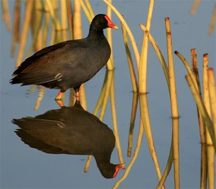Huleia National Wildlife Refuge facts for kids
Quick facts for kids Hulēʻia National Wildlife Refuge |
|
|---|---|
|
IUCN Category IV (Habitat/Species Management Area)
|
|

Hawaiian gallinule - Huleia NWR.
|
|
| Location | Kauaʻi, Hawaiʻi, United States |
| Nearest city | Lihue, Hawaii |
| Area | 241 acres (0.98 km2) |
| Established | 1973 |
| Governing body | U.S. Fish and Wildlife Service |
| Website | Huleia National Wildlife Refuge |
The Hulēʻia National Wildlife Refuge is a special place on the island of Kauaʻi in Hawaiʻi. It's like a safe home for some of Hawaii's rarest waterbirds. This refuge was created in 1973 to protect important wetlands where these birds can nest and find food.
The refuge is next to the Menehune Fish Pond, which is a very old and important historical site. The Hulēʻia Refuge covers about 241 acres (0.98 km²) of low-lying lands and wooded hills. These areas are found along the Hulēʻia River.
Contents
What is a National Wildlife Refuge?
A National Wildlife Refuge is a protected area of land and water. The U.S. Fish and Wildlife Service manages these refuges. Their main goal is to protect wild animals and their natural homes.
These refuges help keep different kinds of animals safe. They also make sure animals have good places to live, eat, and raise their young. Hulēʻia is one of many such refuges across the United States.
Where is Hulēʻia Located?
The Hulēʻia National Wildlife Refuge is on the beautiful island of Kauaʻi. This island is part of the Hawaiian island chain. The refuge is on the southeast side of Kauaʻi.
It sits along the Hulēʻia River, which flows through the area. The land here includes both wet, marshy areas and slopes covered with trees. This mix of habitats is perfect for the birds that live there.
Why is Hulēʻia Special?
Hulēʻia is very important because it protects several types of Hawaiian waterbirds. These birds are endangered, which means they are at risk of disappearing forever. The refuge provides a safe place for them to live and thrive.
Some of the rare birds you might find here include:
- The āeʻo (Hawaiian stilt)
- The ʻalae kea (Hawaiian coot)
- The ʻalae ʻula (Hawaiian gallinule)
- The koloa maoli (Hawaiian duck)
These birds need special wetlands to survive. The refuge works hard to keep these areas healthy for them.
Protecting the Birds and Their Home
To keep the endangered birds safe and undisturbed, the Hulēʻia National Wildlife Refuge is usually closed to visitors. This helps make sure the birds can nest and feed without being bothered. It's very important to protect these sensitive species.
However, there is a place nearby where people can enjoy the shoreline. Just to the east of the refuge, you can visit Niumalu Beach Park. This park offers a way to experience the beauty of Kauaʻi's coast.


